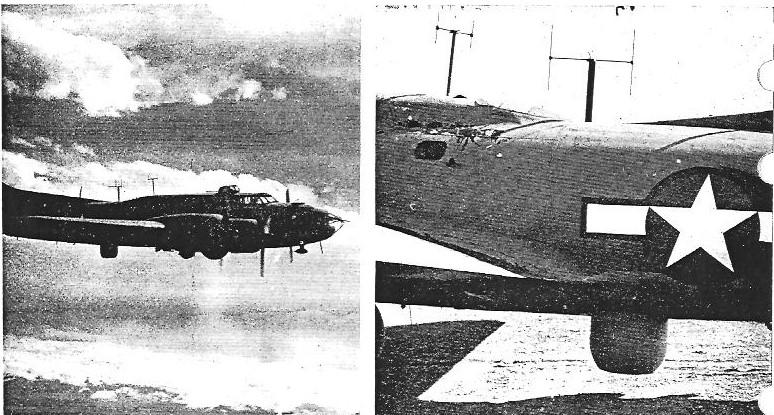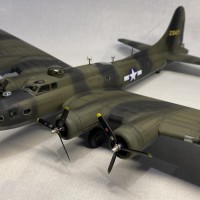Academy B-17F: Mediterranean Ferret
I am always looking for planes to build that are a little out of the ordinary. I came across an article in Aviation Historian about B-17Fs that were used in the Mediterranean as ferrets. A ferret is an aircraft that is designed to detect, analyze, and sometimes jam enemy radio and radar stations.
The British were probably the first to explore using ferrets to counter German radar, but the Americans soon saw the possibilities and began to develop their own ferret program. The first American ferret mission was a B-24D used against the Japanese at Kiska Island in March, 1943. In April, 1943, the 16th Reconnaissance Squadron was established at Foch Field, Tunisia, with 4 war-weary B-17Fs. These planes were filled with detection equipment, including an APA-24 radar in a dome that replaced the belly turret. The bomb bay was filled with additional equipment, as well as the radio operator's compartment which was filled with equipment and additional operators.
The 16th Squadron flew missions to evaluate enemy radars in Sicily, Sardinia, Corsica, Italy, and southern France. Missions were flown solo at low altitude, usually at night. Several planes were lost without a trace. When the ferret mission moved to the Pacific in 1944, these B-17s were so battered that they were simply abandoned in place. In the Pacific, the ferret mission was performed using B-24s, and then later, by B-29s. The important part of this story is the fact that at least two of the 16th's B-17s were camouflaged using black stripes. I was able to find two grainy photos of the plane I wanted to build, one after it was painted but prior to addition of ferret equipment, and another as it was getting ready for a mission. These were enough to move this build forward.
I used the Academy/Minicraft B-17F as the basis for this build.
I added a resin interior, along with additional scratchbuilt equipment to fill-in missing interior items, as well as adding the ferret equipment. This work was largely wasted as most of the interior can't be seen once you build the fuselage.
I replaced the belly turret with a radome taken from a Revell B-17G. The ferret antennas on top of the plane were scratchbuilt using pieces of round plastic strip. I painted the plane using AK Real Colors and Tamiya Paints. It was weathered using artist oil colors. I pieced together the required markings and tail number using Kits-World Decals. One thing I should mention is that this model has excessive dihedral if you build it according to the instructions. (Ask me how I know.) I didn't realize there was a problem until I had already glued everything together. I checked a couple of online reviews which both confirmed the dihedral problem. The good news is that the issue isn't too obvious unless you look at the model directly from the front.
Thanks for stopping by. If you want more info on ferrets or the build, please go to work-in-progress article in the Bomber Group. Cheers.





















Very cool build. I knew about the ferret aircraft but have never seen a build of one. I like it!
Thanks, Jim (@angus64). I was aware of the more recent electronic countermeasure aircraft, but I didn't really know anything about the early days. Interesting stuff, and lots of options for models if you consider the planes the Americans and the British used.
A really wonderful result, George. A rare theme chosen, extremely well researched. Excellent build, painting and weathering. The interior extras might not be too visible, but they constitute a really busy and realistic interior that we know is there. The dihedral problem is not too obvious and it does not detract the eye. Finally, alt of quality work has also been put into fabricating all those external Ferret extra bits.
Your build thread was, as usual great, informative to the last bit, yet pleasant, easily followed.
Congratulations!
Mr friend the late Vic Tatelman (pilot of B-25D "Dirty Dora") operated a ferret on his second tour - a B-25D with a B-25J gun nose - they hunted the radars in the Philippines and then they killed them, making "Dirty Dora II" the first "Wild Weasel".
This is a very interesting model, @gblair.
Absolutely an out of the ordinary B17, George @gblair
Amazing result, exterior and interior, maybe not visible for others but you know it's there and have it on 'film'.
A pity about the dihedral but barely visible when looking to the overall build.
It was a pleasure to follow your thread containing lots of valuable information and I will definitely benefit from it when building my B17.
This is great , well done on doing something different.
Unusual, both the subject as the fortress camouflage. Nice work George, thanks for sharing! I learned something new 😉
Fantastic build and painting! Rally good job!
I never heard of these airplanes before George. it reveals that Radar tech was really becoming the next big thing in conflicts.
Your B-17 is beautifully made and painted .
The B-17 is the first 4 engine plane I build when a Teenager. So long ago that was !
It turned out great, George!
Thanks, Spiros (@fiveten), Tom (@txinla), John (@johnb), Neil (@neil-foster), Pedro (@holzhamer), Bernard (@lis), Bernard (@bernardbedeur), and John (@j-healy). I appreciate all of the kind comments. Bernard (@bernardbedeur): My first plane was the Revell B-47, when it first came out. That really was a long time ago! Tom (@tcinla): I was reading about the B-25s doing ferret/Wild Weasel work in the Pacific. Great story. If anyone is interested, the camo on the second B-17F ferret was even more unusual, but I didn't want to tackle it.
1 attached image. Click to enlarge.
Very interesting story and build! One thing I noticed in this photo as well as the others - the national markings are on top of the extra camouflage. Im guessing these were camo’d in the field, so interesting to me that the markings were then reapplied. Would have thought the camo would just go around the markings, but clearly that isnt the case! This stuff fascinates me.
I noticed the same thing myself, Paul (@feroc). When you look at the photo, it appears the camo was hastily applied, but the markings are quite clean...almost like they reapplied the markings. Also notice there are no de-icing boots on the rudder or elevators. I did some research and discovered that they were sometimes removed in the field if they became damaged. I left them off the rudder and elevators on my model. You can't see the leading edge of the wings, so I painted them on just for variety. There was one thing in the photo that I may try to add at some point when I feel really brave: the bottom of the plane is caked in mud or dust. I wasn't sure if I wanted to try to spray paint the effect, or use something you brush on like the armor guys do, or to use artist's pastel chalks. I don't normally do this much research for a model, but this was fun stuff. Thanks for stopping by.
1 attached image. Click to enlarge.
1. Mud on belly of plane.
2. It appears that mud or dust has sprayed lightly over the bottom of the rudder.
3. Camo stripes appear hastily painted, as well as darker area under national marking where I presume they over-painted previous markings. Tail number and national marking appear pristine. It doesn't look like plane has received ferret equipment yet.
Nice looking Sigint/Elint bird. Not a common sight among model choices, but critical in the ole intel game.
Great piece of research tied into interesting model building, George. Your model represents some of the earliest airborne electronic warfare. Very nice work on both sides of this project.
Thanks, Dan (@dbdleeand) and Bob (@bobd56az). The biggest reason I picked this plane to build was the interesting camouflage, but it became more interesting as I researched the specifics about the mission. Before I started flying in the Air Force, I was assigned to a mobile radar site. Thanks to the enemy radar hunter/killers, our life expectancy in combat was just a few minutes after we turned the radar on. I decided it was much safer to be flying in a war.
This is something that is really unusual, looks great. It's an EF-111 predecessor.
Thanks, Robert (@roofrat). They had some really cool ECM planes in Korea, and a bunch in Vietnam.
Well done, George. I like to see the unusual and interesting subjects and I always learn something new. I like the paint work.
Thanks for the kind words, Gary (@gwskat). I like to build things that are a little different, and this certainly qualified.
@gblair, Thanks for the great aviation history lesson George; I did learn something new today! ? That is so interesting and the resulting model is very nice indeed! Kudos to you sir for your research and execution! ?
Thanks, Gary (@garybrantley). It's my old history teacher genes coming out. Thanks for stopping by.
Well done, enjoyed following along on your build also. It seems to be the way it is, put all that detail inside only to close it up and it barely be visible if visible at all. (Currently doing the same thing with a B-24) I like the overall finish, it looks great.
Thanks for the kind comments, Walt (@luftwaffe-birdman). I think any bomber in 1/72 will have an interior that is virtually invisible, but it was fun to do. Looking forward to your B-24.
Looks fabulous @gblair!
I love unusual subjects, and you certainly found one! I had never heard of these early elint birds. Beautiful project, and pulled off nicely!
Thanks, Michel (@michel-verschuere) and Greg (@gkittinger). As cool as the B-17 ferret is, the B-24 version used in the Pacific is even cooler. I am thinking about adding it to my build list.
Novel and very interesting. Thank you for sharing.
Thanks, Brian (@info4). I am always on the lookout for something a little different, and this fit the bill.